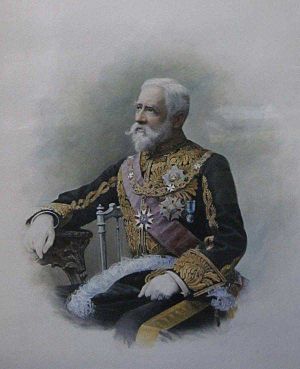Sir Edmund Monson, 1st Baronet facts for kids
Sir Edmund John Monson, 1st Baronet (born October 6, 1834 – died October 28, 1909), was an important British diplomat. A diplomat is someone who represents their country in other nations, helping to keep peace and good relationships. Sir Edmund served as an ambassador or minister in many different countries around the world.
Contents
Early Life and School
Edmund John Monson was born in Seal, Kent, England. He was the third son of William Monson, 6th Baron Monson and Eliza Larken Monson.
He went to a famous school called Eton College. After that, he studied at Balliol College, Oxford University, finishing his studies in 1855. He later became a Fellow at All Souls College, Oxford in 1858.
A Career in Diplomacy
Sir Edmund Monson started working for the British government as a diplomat in 1856. His first job was in Paris, France. He was an "attaché," which means he helped the ambassador. His boss, Lord Cowley, thought he was very good at his job.
This helped him get a new role in 1858. He became the private secretary to Lord Lyons, who was the new British Ambassador to the United States. Lord Lyons taught him a lot about diplomacy.
After his time in the U.S., Monson worked in Hanover and then Brussels. In 1865, he left his diplomatic work for a short time to try and become a Member of Parliament in England, but he was not elected.
Returning to Service
Monson went back to being a diplomat in 1869. He worked as a Consul in the Azores (islands in the Atlantic Ocean). Then he became Consul-General in Budapest in 1871 and later worked in Vienna. He also took on special missions, like one in Dalmatia and Montenegro between 1876 and 1877.
In 1879, he became a minister in Uruguay in South America, staying there until 1884. While in Uruguay in 1881, he married Eleanor Catherine Mary Munro.
After Uruguay, he became a minister in Argentina and Paraguay in 1884. But he soon moved back to Europe. He served as an envoy (another type of diplomat) in Denmark from 1884 to 1888, and then in Greece from 1888 to 1892.
Solving the Butterfield Claims
While he was in Greece, the United States and Denmark asked him to help solve a long-running problem. This problem was called the Butterfield Claims. It was about two ships that were stopped in 1854 and 1855. The ships belonged to a company called Carlos Butterfield & Co. and were thought to be carrying war supplies.
Both countries trusted Sir Edmund Monson to be fair. They agreed to let him make the final decision. Monson decided against the United States. Even so, the U.S. government was happy with his decision and gave him a special gift of silver plates, along with Denmark.
Moving to Belgium and Beyond
In February 1892, Monson was appointed minister to Belgium. But before he left Greece, there was a political crisis. The King of Greece, King George I, dismissed the prime minister. People in Greece hoped Sir Edmund would stay longer because he understood Greek affairs so well. However, he arrived in Brussels in June.
In 1893, Monson was promoted to ambassador. He first became ambassador to Austria and then, in 1896, to France.
Challenges in France
Being the ambassador in Paris, France, was a very difficult job for Monson. At that time, Britain and France had many disagreements. Both countries were expanding their empires around the world, which led to conflicts. They argued over places like Egypt, where Britain had a strong presence, and parts of Africa and Asia.
One big event was the Fashoda Incident in July 1898. French soldiers arrived in Fashoda, a place in Sudan. Two months later, a strong British force arrived. Both sides were polite but insisted they had the right to be there. This situation could have led to war between Britain and France. But thanks to diplomacy, the French government decided to pull its troops out in November.
In December, Sir Edmund Monson gave a speech in Paris. He asked French officials and public figures to stop causing small problems that irritated Britain. He warned that such actions could make Britain take stronger measures. His speech caused a stir in the French newspapers.
However, the situation calmed down. Sir Edmund Monson played an important part in improving relations between Britain and France. These efforts eventually led to the "entente cordiale" (friendly understanding) in 1904. He retired in 1905, leaving behind a much stronger friendship between the two countries.
Awards and Honors
Sir Edmund Monson received many important awards for his work:
- He was made a Companion of the Order of the Bath (CB) in 1878.
- He became a Knight Commander of the Order of St Michael and St George (KCMG) in 1886.
- He was promoted to Knight Grand Cross of the Order of St Michael and St George (GCMG) in 1892.
- He received the Knight Grand Cross of the Order of the Bath (GCB) in 1896.
- He was awarded the Knight Grand Cross of the Royal Victorian Order (GCVO) in 1903 when King Edward VII visited Paris.
- He became a member of the Privy Council in 1893.
- He was made a baronet (a special title of honor) in 1905.
- The French government also gave him their highest award, the Grand Cross of the Legion of Honour.
Family Life
Sir Edmund Monson had three sons. Each of them inherited his baronet title one after the other:
- Sir Maxwell William Edmund John Monson, 2nd Baronet (1882 – 1936)
- Sir Edmund St. John Debonnaire John Monson, 3rd Baronet (1883 – 1969)
- Sir George Louis Esme John Monson, 4th Baronet (1888–1969)
None of his sons had children. So, when Sir George died, the baronet title ended. Sir Edmund's second son, also named Edmund, also became a diplomat.


